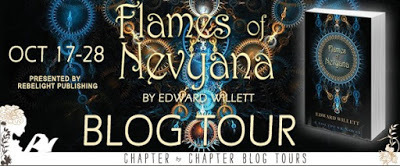Edward Willett's Blog, page 21
October 19, 2016
The world of Flames of Nevyana
From the ongoing blog tour for Flames of Nevyana , here’s today’s guest post from Lisa’s Loves (Books of Course):
The world of Flames of Nevyana began with a simple kernel of an idea: the magic of electricity.
I was driving from my home town of Regina, Saskatchewan, to Meadow Lake (about 500 kilometres north) for a library reading/presentation, and passing the time by trying to come up with a new YA novel idea. I got to musing on what is known in science fiction circles as Clarke’s Law: Arthur C. Clarke’s famous dictum that “Any sufficiently advanced technology is indistinguishable from magic.” I reflected on the fact that what we accomplish with electricity would certainly have seemed like magic to our distant ancestors. From there it was a hop, skip and jump (and another couple of hundred kilometres of driving) to the world of Nevyana, a land of magic—but one where the magic, known as Blue Fire, is essentially electricity, albeit produced and controlled through magical means.
My process of world building is a bit like an oyster crafting a pearl. There’s the initial idea—the grain of sand that irritates said oyster—and then the gradual building up of layer upon layer around that initial irritant/idea. For me, the process takes the form of a series of questions. The first question: how did the people of this otherwise medieval society learn to harness Blue Fire?
I decided that the magic had been bestowed upon them by their gods. Thinking of gods led me to think of how, in Earth mythology, there are often gods of specific aspects of nature: a God of the Earth, a God of Lightning, a Goddess of Wisdom, etc. I ended up with three gods, survivors of a war among the gods that devastated the original home of the people of Nevyana and drove them to a secluded valley, where they have built a new kingdom over the ensuing centuries. I made the three surviving gods the gods of Earth (Vekrin), Sun (Arrica), and Moon (Ell). Then I began thinking about how each of those different gods might approach benefiting their followers.
Vekrin, being of the Earth, would naturally want his people planted and stationary, so I decided he gave his followers access to Blue Fire through the Godstones, massive sources of power (generators, in other words) that cannot be moved and around which the twelve Cities of Nevyana naturally accreted. Arrica, being of the Sun, would naturally want her people to move across the face of the land as does the Sun. As a result, her followers, the Free Folk, obtain Blue Fire through Sunscales—magical versions of solar panels—which collect energy from the Sun during the day and store it for use at night. And Ell, being of the Moon, the ever-changing Moon, chose to change her followers, turning them from ordinary humans into furred, fanged-and-clawed, near-feline Nightdwellers, who cannot bear the light of day, and whose own measure of magic is focused on hunting and hiding.
With those basic ideas in place, the world of Nevyana took shape: a world in which Citydwellers hide inside walls, clustered around the Twelve Godstones strung the length of the Kingdom; the Freefolk of Arrica travel freely through the wilderness, using the Blue Fire they draw from the sun during the day to power a protective, glowing-blue Fence at night; and the Nightdwellers, long alienated from the others, who seek out and kill any followers of Vekrin or Arrica they find in their forests at night. My main characters are three teenagers, each a member of one of these three groups: Petra, a Priest-Apprentice of Vekrin, Amlinn, granddaughter of a leader of one of the Freefolk clans, and Jin, an apprentice Scrollkeeper of the Nightdwellers. They all have reason to mistrust or even hate each other (among other things, Nightdwellers killed Amlinn’s parents when she was a toddler), but they must work together to save their Kingdom when the sacred secrets of Blue Fire are stolen by a renegade priest and a scheming prince and turned toward conquest.
It’s a complex world that all began with a single thought on a long autumn drive northward, and I’m rather astonished myself how much came of that first inkling of an idea. But that’s what makes writing so exciting, for both authors and (I hope) readers.
October 18, 2016
A mini-review of Flames of Nevyana
The Flames of Nevyana blog tour carries on. The first review (well, a kind of mini-review) how now appeared on Paula Johanson’s blog.
A few excerpts:
It’s always a treat to find a new book by Edward Willett. He’s a Canadian writer who can be relied on to put narrative — story, if you prefer — before anything else…
In a few images, Willett presents the differing communities of his protagonists, making these young people and their surroundings distinct and memorable…
Anyone who can write with such immediacy about light, rain, and mystic discipline has my attention!
October 17, 2016
Flames of Nevyana blog tour begins today: here’s the first interview
The Flames of Nevyana blog tour begins today (full schedule here), and it kicks off in grand style with a fun interview I did for Susan Heim on Writing. Susan is also running a giveaway, so head over there to enter that if you’d interested in a free copy of Flames of Nevyana (and who wouldn’t be?).
Here’s the interview part of my guest post over there, which also includes an excerpt.
You’ve written more than 50 books! How do you find the time to be so prolific? What is your writing schedule like?
It’s funny, people think I’m prolific, but to myself I feel lazy—I always think I could be really prolific if I tried.
The truth is, there are two elements to my prolificity. The first is simply the fact that I’m a full-time writer, and have been for…let’s see…23 years as of this writing. All I do is write, so naturally I have more time to do it. The second element is speediness. I’ve written a 100,000-word novel in a month (Shadows, second in my fantasy trilogy The Masks of Aygrima, written as E.C. Blake and published by DAW Books), and earlier this year I wrote a 60,000-word novel in two and a half weeks (Door into Faerie, the fifth and final book in my YA fantasy series The Shards of Excalibur, published by Coteau Books). When all is going well, I write about 1,500 to 2,000 words an hour. That adds up in a hurry.
My writing schedule depends on what I’m working on. I’m not always writing. I write a lot of non-fiction as well as fiction, so often I’m researching instead of writing. When I do get into the writing, I usually put in about four hours a day, in a couple of sessions. I like to write on my laptop out of my office—in a coffee shop or (ahem) bar—when I’m working on fiction. When I’m working on non-fiction, I’m more likely to work at home because I need to spread out reference materials on my desk.
The rest of my day is taken up with email, driving my daughter to and from school/dance/musical rehearsals, playing with the cat (very important), posting to social media, reading, etc.
How did you get the idea for this book?
I was driving from my home town of Regina, Saskatchewan, to Meadow Lake, about 500 kilometres further north, to do a reading at the library. Whenever I’m on my own in the car on a long trip I do a lot of thinking about writing, and on this occasion I deliberately set myself the task of coming up with a new idea for a YA fantasy novel. I got to thinking about Arthur C. Clarke’s famous dictum that “Any sufficiently advanced technology is indistinguishable from magic,” and that led me to think that our mastery of electricity would certainly seem like magic to someone from the Middle Ages. From there it was a short leap to the idea of a magic system based on electricity. In my book, Blue Fire is definitely magic, and is controlled through magical means, but it’s clearly electricity, too. With that idea in mind, I began my usual process of asking myself questions about the world: how would Blue Fire be used? How did the people learn to harness it? Who might be harmed or benefit from it? By the time I got to Meadow Lake, I had the broad outlines of the story sketched out in my head. I think I even talked about it in my presentation that night.
You also write and perform in plays. How does playwriting differ from novel writing?
The biggest difference is that plays are told almost entirely through dialogue. There’s no opportunity to explain what’s going on through paragraphs of exposition; anything you want the audience to know has to somehow be worked into dialogue, without falling into the trap of characters explaining to each other things they already know as denizens of the world of the stage. There are also technical limits. In a novel, I can write, “The sky turned black and began to rain fire.” Nine words, and a vivid mental image. Yet on stage, that effect is nigh impossible to achieve. Special effects of any kind on stage are difficult, expensive, and prone to not working. You end up, again, depending on dialogue: one character telling another how she felt when the sky turned black and began to rain fire.
As an actor and director, when I write plays I’m always conscious of how it can be staged. The simpler you can make the staging and set, the more likely you can find a company to produce the play. That said, if your characters and dialogue are fascinating enough, and your actors skilled enough, they can perform on an empty stage and still make the play a success. As a friend of mine who directs musicals likes to say, “Nobody ever left the theatre humming the scenery.”
To flip things around, though, I think that being an actor and director helps my novel-writing. When I critique or edit, a common problem I encounter is a scene where characters seem to “float”—you’re never sure exactly where they are within their setting. This can be disconcerting if, say, a character is looking out a window one second, and the next is staring into the fire—but there’s been no description of him transitioning from the one location to the next. In my mind, as I write scenes, I’ve always got a firm idea of where each character is in relation to all the others, and I think that useful skill has been honed through directing plays, where the positioning of actors on the stage is vital to the success of a scene.
Which is your first love: writing or performing?
Performing is more fun, but writing is ultimately more rewarding. The reward of performing is immediate, and wrapped up in the joy of the craft itself: of inhabiting another character’s skin for a while, of singing a song beautifully, of moving an audience to laughter or tears and, hopefully, applause. That’s all wonderful, but it’s ephemeral. The play is done, the audience goes home, the moment is gone.
The reward of writing is more subtle, but far more enduring. As a writer, I still inhabit the skin of other characters. If I write a scene beautifully, I may still move my audience to laughter or tears. In that way it’s similar to performing. On the down side, I am seldom made aware of my success: the occasional review, the occasional email from a satisfied reader. But on the up side, and the reason I say writing is more rewarding, a book may last, essentially, forever. William Shakespeare was an actor as well as a playwright, but it is his words that have endured, not his acting. Nobody will remember me as an actor in fifty years (the art of a stage actor is seldom recorded for posterity; movie and TV actors have a better chance of being remembered), but my books will still be around, still finding new audiences, and still moving them to laughter or tears.
Why do you find the science fiction and fantasy genres particularly appealing as a writer?
I write what I love to read. I have two older brothers, and they both read science fiction when I was growing up. I wanted to be like them, so I started reading it too—and I was immediately hooked, as is evident from the title of my first science fiction story, written when I was 11 years old: “KastraGlazz, Hypership Test Pilot.”
For me, writing fiction strictly about the here and now, or the recent past, seems incredibly limiting, like typing while wearing a straitjacket. Science fiction and fantasy allow my imagination free rein; any time in the past, the present or the distant future and any place in this universe or any other are available to me as settings; creatures both human and non-human are at my beck and call to serve as characters; and there is no idea so outré that it cannot be couched in science fiction or fantasy terms and turned into a story.
For me, the question, “Why do you write science fiction and fantasy?” has never made much sense. The obvious question to me is, “Why doesn’t everyone?”
October 14, 2016
Blog tour begins next week for Flames of Nevyana!
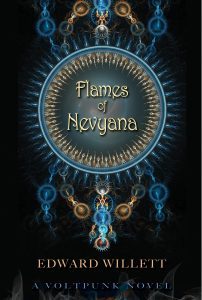 I’m looking forward to the blog tour for Flames of Nevyana, organized by my publisher, Rebelight Books, through Chapter by Chapter. Here’s the schedule–hope you’ll check out everything!
I’m looking forward to the blog tour for Flames of Nevyana, organized by my publisher, Rebelight Books, through Chapter by Chapter. Here’s the schedule–hope you’ll check out everything!
Week 1:
October 17, 2016 – Books,Dreams,Life – Spotlight
October 17, 2016 – Susan Heim on Writing – Guest Post
October 18, 2016 – The Silver Dagger Scriptorium – Spotlight
October 18, 2016 – Paula Johanson Books – Review
October 19, 2016 – Lisa’s Loves(Books of Course) – Guest Post
October 20, 2016 – The Avid Reader – Guest Post
October 20, 2016 – BooksChatter – Interview
October 21, 2016 – Book Horde – Review
Week 2:
October 24, 2016 – Lori’s Little House of Reviews – Review
October 24, 2016 – The Right Geek – Review
October 25, 2016 – The Alchemy of Ink – Spotlight
October 26, 2016 – Chapter by Chapter – Interview
October 27, 2016 – Jorie Loves A Story – Review
October 27, 2016 – Writing about magic and medicine – Guest Post
October 28, 2016 – Rockin’ Book Reviews – Review
September 24, 2016
CanCon and SaskExpo after-action reports
Just since the beginning of September I’ve been to two conventions, one in Ottawa and one in Saskatoon, and both very different.
The Ottawa convention was CanCon 2016, a.k.a. The Conference on Canadian Content in Speculative Arts and Literature. I was Guest of Honour last year (this year the Guest of Honour was Tanya Huff), and returned this year as a special guest. It was held at the Novotel downtown, and once again proved to be one of the best small conventions around, with great panelists and great panel topics.
CanCon has two tracks, a literature track and a science track. Here are the panels I was on, just to give you taste:
The First Great Terraforming Project: Alyx Delamonica, in her address at the Toronto Spec Fic Colloquium, argued that the first great terraforming project is making the Earth sustainably habitable for humans. Our panelists discuss what sustainably habitable looks like and then discuss 21st century tools to begin the process. Alyx Dellamonica, Dr. Alison Sinclair, Katrina Guy, Nina Munteanu, Ed Willett (m)
Why Doesn’t Epic Fantasy Get Any Respect? Or Does It?: It’s been said that it isn’t often that epic fantasy is short listed for the major awards, or even receives critical recognition the same way other kinds of fantasy, science fiction and horror do? Is this true, and if so, why? Ranylt Richildis, S.M. Carriere, Peter Halasz, Evan May, Ed Willett (m)
Youth Gateways into Genre Fiction: Every author can probably, tell you when they first got interested in their chosen genre. Today, though, the way that younger readers are accessing speculative fiction is much different than it was even five years ago. How are new readers being hooked into sci-fi, fantasy or horror? Have there been changes for older readers, too, and has this changed the way we write or market our fiction? Authors of Young Adult fiction discuss. Ed Willett, Leah Bobet (m), Fanny Darling, Mark Shainblum.
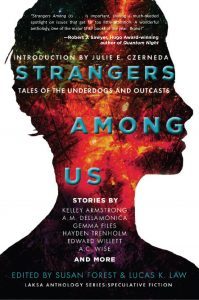 In addition, I took part in the Blue Pencil sessions (reading a piece of writing someone brings to me and making suggestions for improvement), and took part in another launch event for Strangers Among Us, the new anthology from Laksa Media that includes my story “I Count the Lights.” This themed anthology approaches mental illness from a speculative fiction angle, and the publisher is making a donation to the Canadian Mental Health Association from the proceeds.
In addition, I took part in the Blue Pencil sessions (reading a piece of writing someone brings to me and making suggestions for improvement), and took part in another launch event for Strangers Among Us, the new anthology from Laksa Media that includes my story “I Count the Lights.” This themed anthology approaches mental illness from a speculative fiction angle, and the publisher is making a donation to the Canadian Mental Health Association from the proceeds.
Just like the previous launch event I was at in Calgary, this one was emceed by my fellow DAW author Julie Czerneda, who also wrote the introduction. Once again she had each attending author talk a little about the inspiration for the stories.
There are many great writers and great stories in the anthology: check it out! Reviews have been very positive.
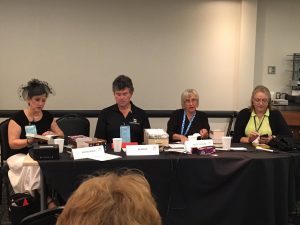 One of the most fun sessions (although you wouldn’t know it from the photo at right (courtesy of Nathan Burgoine), where we’re all concentrating on other things before the panel starts) was a group reading by DAW authors (DAWthors, for short). All of us are edited by Sheila E. Gilbert (who won the Hugo Award this year for best professional editor, long-form, as I just MIGHT have mentioned earlier). We read in the same order as you see us in the photo, left to right: Violette Malan, me, Julie Czerneda, and then the Guest of Honour, Tanya Huff. We each contributed books to a raffle–I gave away a set of The Masks of Aygrma trilogy in paperback.
One of the most fun sessions (although you wouldn’t know it from the photo at right (courtesy of Nathan Burgoine), where we’re all concentrating on other things before the panel starts) was a group reading by DAW authors (DAWthors, for short). All of us are edited by Sheila E. Gilbert (who won the Hugo Award this year for best professional editor, long-form, as I just MIGHT have mentioned earlier). We read in the same order as you see us in the photo, left to right: Violette Malan, me, Julie Czerneda, and then the Guest of Honour, Tanya Huff. We each contributed books to a raffle–I gave away a set of The Masks of Aygrma trilogy in paperback.
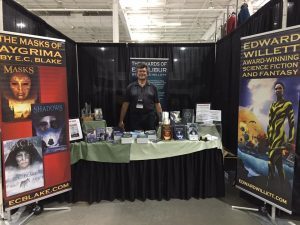 Just a week later (this past weekend, in other words) I was at SaskExpo. This is a growing comic-con style event that this year attracted more than 15,000 visitors. Big-name guests included Carrie Fisher, Tom Felton (Draco Malfoy from the Harry Potter movies), James Marsters (Spike from the Buffyverse) and others. My daughter Alice came up with me and helped some at the table but also had a chance to take in all kinds of panels, get some photos, and get a couple of autographs. Mostly I stood at the table and sold books, and did pretty well, if not quite as well as last year (this year the con decided to put up full-length black drapes to set off the booths and I felt a bit trapped–no sight-lines to anywhere else in the convention, unlike last year.) Lots of new people signed up for this newsletter (hi there, new people!), and I introduced myself and my books to a lot of new readers, so I call that a win. I look forward to next year’s FanExpo in Regina and SaskExpo in Saskatoon, and I keep toying with the idea of maybe trying Calgary…
Just a week later (this past weekend, in other words) I was at SaskExpo. This is a growing comic-con style event that this year attracted more than 15,000 visitors. Big-name guests included Carrie Fisher, Tom Felton (Draco Malfoy from the Harry Potter movies), James Marsters (Spike from the Buffyverse) and others. My daughter Alice came up with me and helped some at the table but also had a chance to take in all kinds of panels, get some photos, and get a couple of autographs. Mostly I stood at the table and sold books, and did pretty well, if not quite as well as last year (this year the con decided to put up full-length black drapes to set off the booths and I felt a bit trapped–no sight-lines to anywhere else in the convention, unlike last year.) Lots of new people signed up for this newsletter (hi there, new people!), and I introduced myself and my books to a lot of new readers, so I call that a win. I look forward to next year’s FanExpo in Regina and SaskExpo in Saskatoon, and I keep toying with the idea of maybe trying Calgary…
I did have to duck out of SaskExpo on Sunday afternoon to run downtown to be part of Word on the Street Saskatoon, the third year in a row they’ve had me on. I was on a half-hour two-person panel with Arthur Slade, talking about “prairie magic”–how we have both used and been inspired by the prairies in our fantastic fiction. We each read a short bit (he read the opening of his newest novel, Flickers, and I read from Door into Faerie) and then just kind of interviewed each other. It went very well, then I dashed back to SaskExpo for the final 45 minutes–and sold a few more books in that last stretch, so it was worth it.
No more conventions for a while now, after four in two months! Guess I’ll have to get back to that other thing I do…what do you call it?…oh, yeah. Writing. :)
September 7, 2016
Another Seven-Sentence Short Story
At When Words Collide in Calgary this summer I once again conducted a Seven-Sentence Short Story workshop, and had more people in it than ever before–30 or so, I’d guesstimate. This is a plotting exercise created by SF writer/high school teacher James Van Pelt, and it works great in this setting.
Below is my story written during that exercise, with each sentence prefaced with the corresponding instruction.
1. Introduce what the main character wants and the first action he/she takes to accomplish that goal.
Stanislaw crawled through the stinking mud of the escape tunnel on his hands and knees, screams chasing him through the darkness, the dim blue light that promised freedom glowing in the distance, seemingly just out of reach but drawing closer with agonizing slowness.
2. The results of the action the charact takes in sentence #1 has to make the situation worse. The character should be farther from the goal now.
Breathing hard, he reached toward the light, jerking his questing fingers back to his side as he felt the brush of a wire against them, but not quickly enough to keep from triggering the land mine that swallowed that faint blue light in smoke and flame, the shockwave a moment later hammering him into the mud with an ear-splitting roar and blast of hot air and steam.
3. Based on the new situation, the character takes a second action to accomplish the goal.
He spat filth from his mouth and then, jaw set, began backing up: he had no choice now but to take the other branch of the tunnel, the one he’d been warned to avoid—however dangerous it might be, he knew it led out, and returning to the camp would net him nothing but an agonizing death in the torture chamber.
4. The results of the second action the character takes from sentence #3 is to make the situation worse. The character should be even farther from the goal now.
Then he saw the deep green glow ahead of him that could only mean this path led to the lair of Chall, the poison-spitting devil’s worm whose nightly patrols had worn a deep groove in the ground just outside the camp’s stone walls, and he wondered if death in the torture chamber might actually be preferable to what might await him here.
5. Based on the new situation, the character takes a third and final action to accomplish the goal.
But there could be no turning back, and it wasn’t like Stanislaw was completely helpless: he pulled from his belt the obsidian knife he had laboriously chipped in secret night after night in his cell, the blade that had conjured the screams of the crippled guards that had followed him down the escape tunnel, and holding it thrust out before him, crawled out of the tunnel and into the devil-worm’s lair.
6. The third action either accomplishes the character’s goal, fails to accomplish the goal, or there is an unusual but oddly satisfying different result of the last action.
He hardly believed his luck: the devil-worm slept, stretched out like a cat on its back, its soft belly exposed, and he gathered his legs beneath him, leaped forward, and drove the blade into the soft flesh.
7. The denouement. This sentence wraps up the story. It could tell the reader how the character felt about the results, or provide a moral, or tell how the character’s life continued on.
But as the flesh parted, and sucked him in, and his vision changed, and his legs and guts twisted, and the blade became claws, and his teeth became fangs, he realized that the devil-worm was not a beast at all: for a brief brush of thought that was not his own touched his mind, a heartfelt “At last,” wrapped in immense relief, and he recognized the voice, and recognized the awful truth—the voice belonged to Victor, the last prisoner who had attempted escape, and Stanislaw had now taken his place, for the rest of his miserable existence, as the final guard of King’s strongest prison.
September 5, 2016
The Space-Time Continuum: The Encyclopedia of Science Fiction
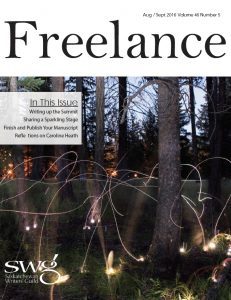 My “Space-Time Continuum” column for the August/September 2016 issue of
Freelance
, the newsletter of the Saskatchewan Writers Guild.
My “Space-Time Continuum” column for the August/September 2016 issue of
Freelance
, the newsletter of the Saskatchewan Writers Guild.
When I was growing up, in pre-Google days, my go-to book for anything I had a question about was the 1958 edition of Collier’s Encyclopedia, which my parents had bought before I was born.
One thing I couldn’t learn much about in Collier’s or any other encyclopedia, however, was science fiction. I had to rely on bits and pieces gleaned from the introductions to books and stories, and the occasional magazine article.
All that changed in 1979 with the publication of a massive reference work called The Encyclopedia of Science Fiction. Almost 40 years later, it continues to be indispensable for anyone wanting to learn about the field. Best of all, it’s now online—a science fictional form of publishing un-thought of when the first edition came out—and continually updated. As of July 2016, it stood at a whopping 5,185,363 words. That’s a far cry from the first print edition, which contained “only” 730,000.
The encyclopedia was the brainchild of Australian writer Peter Nicholls, while he was living in Britain in the mid-1970s. He took on the role of General Editor, and in 1975 asked John Clute if he would like to be Associate Editor, with primary responsibility for the entries on authors. By doing so, he gave the encyclopedia a Canadian connection.
John Clute was born in Toronto in 1940, and lived there until 1956. He spent the next few years in the U.S., during which time he obtained a degree at New York University, and since 1968 has lived in London. Although he’s published a couple of novels and a few short stories, he’s best-known for his non-fiction: he’s widely considered one of the most important critics and observers of the science fiction field. Which, of course, made him a natural fit for the encyclopedia, which he wrote along with Nicholls and John Grant.
The original idea was that the encyclopedia would contain an entry for every writer who had published so much as one book of science fiction. However, the editors were surprised to discover just how many writers that mandate encompassed—and how many writers had written science fiction novels without being connected to the field. (Or, probably, acknowledging they had done any such thing.)
Of course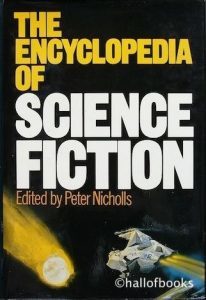 they never reached the end of searching, not for the first edition in 1979, not for the second edition in 1993 (for which Clute wrote another 500,000 words covering 2,300 writers), and not for the current online-only third edition, although Clute notes today he finds fewer forgotten writers, while having to notate the arrival of hundreds of new ones.
they never reached the end of searching, not for the first edition in 1979, not for the second edition in 1993 (for which Clute wrote another 500,000 words covering 2,300 writers), and not for the current online-only third edition, although Clute notes today he finds fewer forgotten writers, while having to notate the arrival of hundreds of new ones.
The encyclopedia covers more than just authors, of course. It also lists and explains themes from A (i.e., “Absurdist SF”, “Afrofuturism”) to Z (“zeppelins,” “zombies”), and also has entries on media (comics, films, movies, TV), and culture (awards, fans, conventions, magazines). Crosslinks and hyperlinks abound in every entry.
The fact the encyclopedia ever made it to a third edition is rather lucky. The first edition was prepared under a work-for-hire contract for book packager Roxby Press, which then sold rights to Granada in the U.K. and Doubleday in America. Since it was work-for-hire, the editors retained no rights, which meant there could not be a second edition until those rights were obtained. John Clute (who in the interim continued to maintain an alphabetical list of entries into which he fed any information that came his way) finally managed to buy back the rights, setting the stage for the second edition, 600,000 words longer than the first, published in 1993 by Macdonalds (later Little Brown UK).
Clute noted in an interview that one problem they faced even after they obtained the rights was the fact that the original manuscript had been stored on eight-inch floppy disks, which, he wryly commented, “were designed to turn widdershins and were only readable by a handful of Singer typesetting machines, which may have all been junked by 1990.” It would have been ironic had the second edition of the definitive science fiction encyclopedia been done in by advances in technology, but in the end it was saved—not because they ever found any way to read those floppies (they didn’t) but because they instead convinced the publisher to hire typists to re-key the entire first edition.
The second edition was reprinted in 1995 and augmented in 1999, in both cases with an appendix listing corrections and addenda. A CD-ROM version, adding more than 65,000 words, appeared in 1995.
The third edition was first released in 2012 by a new company, ESF, Ltd., in association with Victor Gollancz, the science fiction and fantasy imprint of the Orion Publishing Group, and made free to all users. It continues to be free.
Whether you want to know more about a particular book or author or whether you’re just interested in a little serendipitous browsing, you can find The Encyclopedia of Science Fiction at www.sf-encylopedia.com.
And yes, within its thousands of entries, you’ll even find one for me.
September 2, 2016
My editor wins a Hugo! And other stories of what I did on my summer vacation
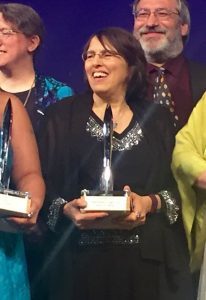 It’s been a while since my last post. Lots to tell you about, but let’s start with the most important: my wonderful editor (and publisher), Sheila E. Gilbert of DAW Books, received the Hugo Award for Best Editor (Long-Form) at this year’s World Science Fiction Convention in Kansas City–and as you can see, I was there to take a photo. :)
It’s been a while since my last post. Lots to tell you about, but let’s start with the most important: my wonderful editor (and publisher), Sheila E. Gilbert of DAW Books, received the Hugo Award for Best Editor (Long-Form) at this year’s World Science Fiction Convention in Kansas City–and as you can see, I was there to take a photo. :)
Sheila mostly operates out of the limelight: she doesn’t have a huge social media presence and she’s not all that likely to show up on panels at conventions. But behind the scenes she does amazing work with writers, helping them make their stories the best they can make them. In fact, the day after she won the Hugo, she met with me to discuss my next science fiction novel for DAW Books, The Cityborn, coming out next July. There’s no doubt that the revisions I’ll make in response to her suggestions will make the book stronger and better. So way to go, Sheila! Nobody deserves it more.
She also gave the best acceptance speech of the evening, which you can watch on YouTube.
WorldCon in Kansas City was great from my point of view. I was on four good panels talking about YA fiction (I think my favorite was the one about “Latchkey Kids,” i.e., why do we get rid of the parents so often in YA books?), met some fascinating people, and really enjoyed the panels I attended, which were mostly science-focused rather than science fiction focused. (A Q & A with astronaut Stan Love was particularly enjoyable).
After Kansas City, we went down to Adrian, Missouri, a small town about an hour south of there, and stayed on my cousin’s farm for a couple of days. While there we made a pilgrimage into the slightly larger town of Butler, Missouri, where my mother (and next-oldest brother) were born, but which is also notable in science fiction circles for being the birthplace of Robert A. Heinlein, way back in 1907. Since my daughter enjoys Heinlein (i must be doing something right) I made sure to get a picture of her in front of his birthplace. Really just an ordinary house, but at least it’s still there! There used to be a nice sign out front on two posts; currently it’s leaning discretely against the house.
Then we paid a visit to the Butler Public Library, which has a wing and reading room built with money donated by the Heinlein estate (specifically by his widow, Virginia Heinlein). There are several early and collectors’ editions of his books there, and the librarian had just come back from Jefferson City, where a bronze bust of Heinlein, to be displayed in the Capitol Building, had just been unveiled as he was inducted into the Hall of Famous Missourians.
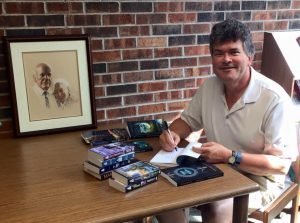 When I found out they had none of my books, and they’re completely self-funded, i decided I could remedy that, and expand their collection a little bit, by donating as many books as I could from those I’d taken down there with me. Which is what I’m doing in the photo . They were really happy to get the books and I was very happy to give something back (or, as Heinlein would put it, “pay forward”) to a library in a town with a family connection…and one with a connection to Heinlein, one of my favorite writers growing up and a huge influence on my becoming a science fiction writer.
When I found out they had none of my books, and they’re completely self-funded, i decided I could remedy that, and expand their collection a little bit, by donating as many books as I could from those I’d taken down there with me. Which is what I’m doing in the photo . They were really happy to get the books and I was very happy to give something back (or, as Heinlein would put it, “pay forward”) to a library in a town with a family connection…and one with a connection to Heinlein, one of my favorite writers growing up and a huge influence on my becoming a science fiction writer.
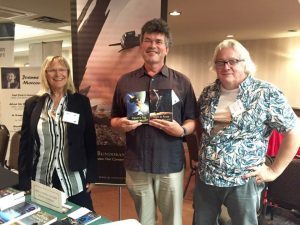 Before we headed south to Kansas City, we were in Calgary for When Words Collide (I posted my busy schedule for that last time). it went really well, as well; it continues to be my favorite writing conference every year, and I strongly urge you to try to get there if you are interested in writing or books. One more photo, of me with Liz and Hayden Trenholm of Bundoran Press, publisher of my Peregrine Rising duology, Right to Know and Falcon’s Egg.
Before we headed south to Kansas City, we were in Calgary for When Words Collide (I posted my busy schedule for that last time). it went really well, as well; it continues to be my favorite writing conference every year, and I strongly urge you to try to get there if you are interested in writing or books. One more photo, of me with Liz and Hayden Trenholm of Bundoran Press, publisher of my Peregrine Rising duology, Right to Know and Falcon’s Egg.
 My last event at When Words Collide was also one of the best: the launch of Strangers Among Us, the new anthology from Laksa Media that includes my story “I Count the Lights.” This themed anthology approaches mental illness from a speculative fiction angle, and the publisher is making a donation to the Canadian Mental Health Association from the proceeds.
My last event at When Words Collide was also one of the best: the launch of Strangers Among Us, the new anthology from Laksa Media that includes my story “I Count the Lights.” This themed anthology approaches mental illness from a speculative fiction angle, and the publisher is making a donation to the Canadian Mental Health Association from the proceeds.
The launch was emceed by my fellow DAW author Julie Czerneda, who also wrote the introduction. Rather than try to have the attending authors read anything (there wasn’t time with that many authors) she instead had us talk a little bit about the inspiration for the stories. Many of the authors had a family or personal connection to mental health issues: it was actually very moving. And someone told me how much they loved my story, which was great to hear.
There are many great writers and great stories in the anthology: check it out! Reviews have been very positive.
August 9, 2016
My “When Words Collide” schedule
I’ll be at the fabulous When Words Collide writing/reading conference in Calgary next weekend (May 12-14). They’re keeping me busy. If perchance you will also be attending, here’s where you can find me. (If you aren’t attending, it may be sold out this year, but if you’re interested in writing and can make the journey, it’s totally worth it.)
Friday 3 PM – Fireside
Live Action Slush – Early Bird Edition
Edward Willett (reader), Mark Leslie (Lefebvre), Colleen Anderson, Rhonda Parrish, Tod McCoy
Bring the 1st page of your short fiction manuscript to be anonymously read aloud and receive comments from our editors.
Friday 5 PM – Canmore
YA Inspiration
Edward Willett, Nancy M Bell, Joan Donaldson-Yarmey, Sherry Peters
Where writers get their inspiration for their YA stories – how to use stories from your own surroundings and techniques for idea generation.
Saturday 10 AM – Willow Park
How to Write a Good Pitch & Query
Robert Runte, Eve Silver, Edward Willett, Adrienne Kerr, Samantha Beiko
You can write the greatest novel ever written, but you still need to get it into the hands of a publisher. Our panel tells you how.
Saturday 12 PM – Bonavista
Creating Magic Systems
Swati Chavda, Chris Jessop, Edward Willett, Allan Weiss, Erin Lindsey
Creating Magical Systems is an art form all in itself. Join us as panellists discuss their process for creating and maintaining their magical systems.
Saturday 1 PM – Heritage
Blue Pencil Café
Edward Willett
Bring the first page or two of your manuscript (max 1000 words, typed, double-spaced) for 1-on-1 feedback from an editor.
Saturday 4 PM – Acadia
The Seven-Sentence Short Story
Edward Willett
This is a fun exercise in plotting, created by SF writer James van Pelt: participants build a complete story in just seven sentences over the course of the hour, complete with inciting incident, rising tension, complications, climax, and denouement. At the end of the hours, everyone has a finished piece of writing. Writers are invited to share their work if time permits, but they don’t have to.
Saturday 8 PM – Parkland-Bonavista-Willow Park
Autograph Session (2 Hours)
Our Festival Guests are joined by 70+ authors
Drop by to meet the authors and get your books signed. This session is open to the public, so tell your friends.
Sunday 10 AM – Fireside
Books in Conversation
Edward Willett, Teresa van Bryce, Greg Bechtel, [?]
Books and texts are often said to be in conversation with each other, with some writers openly discussing how they wrote something in response to another work. The classic example is Samuel R. Delany’s Triton and Ursula K. LeGuin’s The Dispossessed. A more recent example is Lev Grossman’s Magicians books, which are particularly in conversation with the work of C.S. Lewis and J.K. Rowling. Our panellists will discuss what their work is reacting to, and talk about where this impulse comes from.
Sunday 12 PM – Kananaskis 2
Writers at the IMPROV
IFWA, Edward Willett
Attend this hilarious panel where teams of writers use audience suggestions to create a speculative fiction story. The results can–and have–been out of this world.
Sunday 1 PM – Canmore
Middle Grade and YA Sequels and Trilogies 1-2-3
Danielle L. Jensen, Edward Willett, Michell (Mike) Plested, Shirlee Smith Matheson
What are the advantages/challenges with writing series for youth? Story arcs, that dreaded middle book, and mixed reactions from readers. Authors of both middle grade and young adult fiction share how their series were written, marketed and received by readers.
Sunday 3 PM – Fireside
Fulltime Freelancing: The Good, the Bad, and the Ugly
Edward Willett
Edward Willett has dreamed of being a fulltime writer since he was a teenager, and in 1993 he took the plunge. He’s been a fulltime freelancer ever since, and written everything from science fiction and fantasy novels to children’s biographies (of subjects ranging from the Ayatollah Khomeini to Jimi Hendrix), books about diseases, computer books, local history books, books about skateboarding, rock climbing, and becoming a mason, and more. In this presentation he describes why he plunged into fulltime freelancing, how he’s managed to keep his writing career afloat for more than two decades—and how reality compares to the dream he nourished for so long.
Sunday 4 PM – Kananaskis 1
Laksa Media Presents
Susan Forest, Lucas K. Law, Amanda Sun, Bev Geddes, Edward Willett, Sherry Peters, Erika Holt, Robert Runté, Hayden Trenholm, Julie E. Czerneda, Vanessa Cardui
Join Laksa Media’s publisher, editors and authors for the book social launch of STRANGERS AMONG US anthology: Tales of the Underdogs and Outcasts, exploring the delicate balance between mental health and mental illness and supporting Canadian Mental Health Association. Refreshments, door prizes, lively conversation, teasers readings, Q&A, upcoming projects, and music.
August 4, 2016
My WorldCon schedule

I’m looking forward to being in Kansas City in a couple of weeks for the World Science Fiction Convention. I’ve got my complete schedule now: if you’re attending, hope to see you there!
New Trends in Young Adult Novels
Thursday 12:00 – 13:00, 2503A (Kansas City Convention Center)
What’s new in young adult fiction? It seems like YA changes faster than anything else in the market, but is that really true? What themes are hot today? What topics are now taboo? And what can we look forward to in the near future?
Ms Rachel Neumeier, Christine Taylor-Butler (M), Jane Ann McLachlan, Edward Willett, Denise Grover Swank
Middle Grade and Young Adult Fiction: What’s the Difference?
Thursday 17:00 – 18:00, 2208 (Kansas City Convention Center)
YA and MG, it’s all just kids lit, right? Not necessarily. James and the Giant Peach is a much different story than The Hunger Games, and yet the two audiences often get lumped together — like we’re doing here. So, let’s break them apart. Panelists discuss defining characteristics of Young Adult and Middle Grade fiction, differences in world view, special problems — and provide some literary examples.
Kathryn Sullivan (M), Christine Taylor-Butler, Rebecca Moesta, Edward Willett, Adam-Troy Castro
Latchkey Kids in Fiction
Friday 10:00 – 11:00, 2206 (Kansas City Convention Center)
Parents are often missing (or at least sidelined) in today’s young adult fiction. With the emergence of these latchkey kids who come home to empty houses and who have very little (if any) parental supervision, what message is this sending to today’s readers? What purpose do these absentee parents play in the larger story? Sure, it ratchets up the tension, but why is it such a common theme? Moreover, what resources are available to these latchkey kids and what dangers should they keep in mind when operating without a parent?
Tina Connolly (M), James Van Pelt, Tamora Pierce, Sarah Beth Durst, Edward Willett
Kaffeeklatsch: Jennifer Brozek, Ken Liu, Bud Sparhawk, Edward Willett
Friday 15:00 – 16:00, 2211 (KKs) (Kansas City Convention Center)
Autographing: Ctein, Tanglwyst de Holloway, Esther Friesner, James Patrick Kelly, Kathryn Sullivan, Edward Willett
Saturday 11:00 – 12:00, Autographing Space (Kansas City Convention Center)
YA Fiction Beyond Borders
Saturday 17:00 – 18:00, 3501F (Kansas City Convention Center)
Young adult fiction is a strong and thriving market in the U.S., but how is it doing internationally? We discuss the books and authors beyond mainstream “America’s literary borders” that deserve recognition. Is there a difference in approach, content, characters, and diversity of topics and themes? How do we continue to break down these borders and barriers for YA readers and authors alike?
Mr. Peadar O Guilin, Keith Yatsuhashi, Shanna Swendson, Edward Willett, Christopher Kastensmidt (M)
Reading: Edward Willett
Sunday 13:30 – 14:00, 2202 (Readings) (Kansas City Convention Center)

